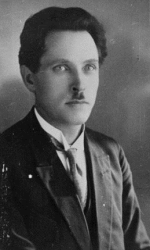Uniting Ruhnu with the Republic of Estonia 



On 17 January 1919 the Provisional Government of the Republic of Estonia passed the following law: "To proclaim the Island of Ruhnu as part of the Republic of Estonia". The decision, at that moment, was of a symbolic nature - the island in winter was cut off from the mainland and there was no-one able to tell the news to the islanders. Apathy towards the little island lasted throughout the spring. On 23 May 1919 money was allocated to "buy seal blubber from Ruhnu island", and permission was granted to take cartridges, guns, leather, petroleum and foodstuffs to the inhabitants. The "Ruhnu Island Commission" set out for the island. The commission made a stopover in Kuressaare where its members were compelled to "turn to experts in order to obtain useful tips about the customs and traditions of the islanders so that the expedition would be an unqualified success." Having reached the island, the commission tried to convince the inhabitants, in Swedish, that the government of the Republic of Estonia was keen to fulfil their wishes and protect their interests. After a few hours of negotiations the delegation was permitted to land. The final decision regarding the status of Ruhnu, however, was delayed - according to the Ruhnu custom it could only be given by local community – Loandskape. Terms of sale and purchase were agreed upon beforehand. The islanders sold seal blubber and received cash and exchange goods (salt, wheat flour, petroleum, guns, cartridges, but also spirits and wine). The people of Ruhnu agreed to join the Republic of Estonia, and the "expedition" returned to the mainland. Unfortunately the purchased seal blubber was of no use in Tallinn and soon went bad because of unsuitable preservation conditions.
In the beginning of 1921, the people of Ruhnu sent the Swedish government a letter with the request for Sweden to annex the island. The reason lies behind the peoples’ dissatisfaction with the Estonian authorities. During calmer times, in contrary with the earlier promises, it was demanded that the island´s young men would serve time in the Estonian army. They were also not satisfied with the high taxes and the fact that they were not allowed to chop wood for their own use from the state forest. In the summer of 1921, State Elder Konstantin Päts visited the island, in the meeting with village elder Hans Steffens the island´s uniting with Estonia is discussed. In 1922 the Estonian government adopts the decision that the conscripts of Ruhnu can serve time in the island´s lighthouse. Motivated by the information that unknown persons are making anti-Estonian propaganda on the island, in August 1923 the minister of the interior Karl Einbund visited the island. Finally the requests of Ruhnu people found a more lasting solution on the government level: the government confirmed the proposal of the ministry of interior to arrange the Ruhnu island´s military obligation service in a way that during the war the mobilization-aged could perform the defence, communications or other service on the home island. Giving the people of Ruhnu heating material from the island´s forest for free is also confirmed to be necessary, taking into account the decision of the parish council „according to the local customary law“ . Latvia discarded its pretentions for Ruhnu island in November.
Further reading
- K. Jaanson. Ruhnu ühendamine. – Tänapäev nr 35, august 1991 (In Estonian)
Created in 2013





